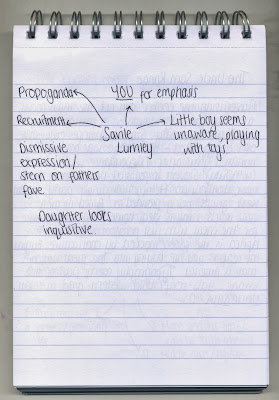Lecture Notes:
Visual Literacy: Interpret, negotiate and make meaning from information presented in the form of an image.
This was something I really hadn't thought about until it was presented in this lecture, I was fascinated as I realised that in actual fact these symbols were just lines but the human mind links them to a public toilet due to the generalisation of society doing the same as a whole. Even though the sign is in a different language our eyes are immediately drawn to the familiar symbols rather than the writing and even though the symbols are not exactly the same as those found in England we still make an instant assumption because 'pictures can be read.'
Visual Literacy: All that is necessary for any language to exist is an agreement amongst a group of people that one thing will stand for another.
I became very aware in this lecture of how important the context or characteristics of an image or symbol could influence it and change it dramatically. By just using the same shape and altering certain factors of it such as colour and context it could be interpreted in several different ways. A black cross to me instantly represented a substitute for the word 'and', however as the slides progressed and the context developed it was clear it was there to show a plus sign, this was only apparent when other relative symbols were revealed. Changing the one factor that is the colour also had great effect on what this symbol was standing for, as soon as we see it in the colour red we think first aid, but green cross comes to mind when the colour changes again to green.
My interpretation of this was that basically there are certain elements to an image that are required for a person to read it in a particular way, this is a rule that applies to everything.


These three images all make me feel different emotions towards them. But why? This is where visual syntax elements play their part and influence the audience to feel different emotions towards these images reflective of their characteristics. For me, personally and what I presume the majority of other people there is a huge contrast between the aesthetics in these two images which have an effect on how appealing or attractive they are to us. The first word that comes into my head when looking at the top image is unappetising, on closer inspection I realised that this is because of several factors; firstly the composition of the food and the ratios of it, secondly the over contrasting colours of the image and the small frame used. It makes the image seem claustrophobic and the food looks cheap and greasy. So why is the second image so much more appealing? I initially became more attracted to the second plate of food, this is because the image looks more professional, with a higher resolution and the use of aperture the image seems more thorough and reliable, almost more legit. More subtly, there is the use of green herbs in the frame, these have connotations of healthiness and nature but are not glaring at us immediately therefore it is more a subconscious recognition.


This logo or sign is one that is universally recognised, this is because it is an established sign, it has played a huge part in fashion and culture and is iconic in any context. It holds reference to social ideals, cultural references and social interaction and has become popular all over the world, it is adapted in many different ways by people who use the connection as a factor to draw people in.
This is a brilliant example of how the format is used to represent different meanings but is still linked to the first image and the red symbol is a way of specifying a feeling, in this instance it is open to interpretation, love? Hate?
Semiotics is the study of signs and sign processes and either their use or their interpretation, until I saw the examples I found it difficult to get my head around this definition.
The symbol and the sign can be two very different things as shown above, it symbolises a real life object, something physical but something that looks very different to the symbol itself, however we still recognise it as an apple. As a sign it is linked specifically with the Apple brand and has no connection to the fruit apple but only to the company, this is something we rarely question. The signifier is what connotations we believe derive from the sign itself, so what does the company represent, the products and characteristics.
There are several different forms of synecdoche examples including:
- A synecdoche may use part of something to represent the entire whole.
- It may use an entire whole thing to represent a part of it.
- It can use a word or phrase as a class that will express less or more than the word or phrase actually means.
- It may use a group of things that refer to a larger group or use a large group to refer to a smaller group.
- A synecdoche may also refer to an object by the material it is made from or refer to the contents in a container by thename of the container.
I found this a really easy concept to get my head around, in many circumstances just seeing part of an image can allow us to recognise the whole of it and make the connection between a small fragment of it and the entire thing. It would be interesting to see how small of a part of an image could be before it was unrecognisable.
Often used in advertising, a visual metaphor relates to an image that is reflecting a different meaning or similar perception. It is often used in advertising and can be a good way or convincing or persuading via visual media.





















































